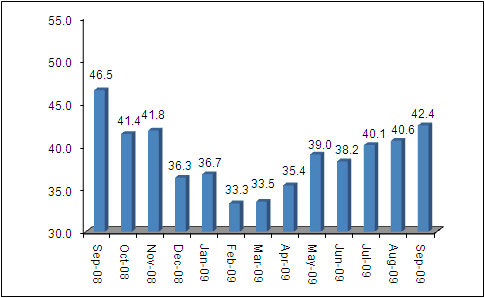Recently released labor market, manufacturing, and consumer data indicate an economy steadily emerging from the long recession. One of the most gratifying indications of this change was the Associated Industries of Massachusetts Business Confidence index showing a continued gain of 1.8 points in September for an overall business confidence level of 42.4 (the highest since September 2008).
 |
| AIM Business Confidence Survey |
Despite the changes, confidence levels in manufacturing have not returned to the point where there is a general belief that the current improvement is permanent, at least for manufacturers in New England.
…
Comments
Following the false data trail
I am amazed at how supposed quality people can fall for the oldest trick in the book, government backed data. Of course the picture is rosy and everything is back on track and looking good (according to the government). However perform a gut check in reality land. Lay offs are continuing and joblessness remains at an all time hight. The CBOE VOLATILITY INDEX or VIX, is going in the opposite direction (30 and climbing). I actually work in manufacturing, and orders for our goods remain flat or are decreasing in the United States.
The real picture:
Jittery retailers are slashing inventory prices already, expecting a sales year much worse than that of 2008. The retail sales numbers that Jack refers to are people picking up on those early bargains. Retail will eventually turn into a bargain basement fury, before the first week of December, as retailers literally dump inventories to save them selves from bankruptcy. The result will be extremely low to negative profit margins in the retail market for 2009. Resulting in greatly reduced credit ratings for retailers in 2010.
Market investors will avoid the retail markets like the plague, seeing their losses mount up for two consecutive years. This will continue to effect the market until essential items will be the only solid investment opportunities. Non essential retail items will continue to fall until they reach a point of prepaid, order only, status (just as the aircraft industry is now).
What you are watching occur is actually the death of the current retail marketing method of forecasted sales and forecasted inventories for non-essential items.
State governments have watched their budgets dwindle by billions of dollars and are using federal funds to prop up employees that are no longer needed and can not be afforded. The retail industry will undergo a slaughter house of job losses in early 2010, along will extreme reductions in real estate rentals (look for malls to have plenty of extra space).
With nearly (real number) 15% of Americans currently out of work and another 4% - 5% facing layoff from the failing retail industry, combined with the worry of the remaining employed, retail sales for anything other than necessary items will dwindle to an all time low.
People use your common sense, look at the escalating foreclosures, look at the job losses, look at the retail dumping that is occurring right now, look at the volume of out of state tags in areas where there is any work available, does this look like an economy that is coming out of recession?
We are now 9 months into the 18 months of the stimulus which promised 3-4 million new jobs. Now we are being told 1 million education jobs have been saved (of course without support data). Its near impossible to see us gain 3-4 million jobs in the remaining 9 months, knowing the losses looming in the retail industry.
Manufacturers who wisely prepare for a market swing toward customer orders, and who have the reaction timing to meet market demand, will be the winners.
Add new comment